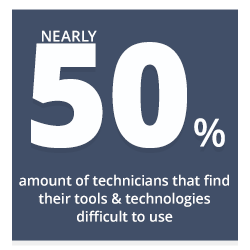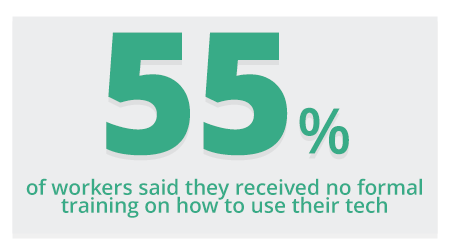Field service software is critical for field organizations that want to deliver high-quality service to their customers, optimize their workflows and reduce their costs. However, poor adoption and incorrect usage of your field service applications can have a direct impact on service delivery and result in significant adverse financial outcomes.
Why? With field technologies so tightly integrated with field sales & service workflows, achieving technology adoption and proficiency is critical to organizational success. According to an IFS survey, change management and user adoption of new technology were ranked among the top 3 challenges (37%) service organizations currently face.
The reality is that poor adoption and user proficiency with software applications can create significant downstream issues such as: missed service level agreements (SLAs), low first-time fix rates, increased parts leakage, reduced technician utilization, and dissatisfied customers.
In our previous report, “Maximizing Field Productivity with Performance Support & Workflow Learning” we outlined the key factors contributing to poor app utilization and how to create better performance support through workflow learning.
In this article we’ll discuss:
Why underperforming metrics might be a leading indicator that you have a tech adoption issue
How poor software utilization is leading to problems in service operations
How workflow learning can lead to better adoption of application workflows and dramatically improved KPIs

Houston, We Might Have A Problem
Your KPIs and service metrics provide a view into the health of your service operations. When key metrics are underperforming, the root cause isn’t always immediately clear. However, a good place to start is looking into your key business systems (such as field service automation or ERP), since they might give clues as to where key processes are breaking down.
A primary reason field service workflows are frequently executed incorrectly and inconsistently is that employees lack the necessary proficiency with their field service software and technology. Complex workflows that are highly intertwined with mobile field service applications, create an environment where confusion and errors can easily arise.
In our conversations with leaders of large service organizations, we’ve uncovered several have acknowledged that misuse of app workflows is leading to chronic errors in the field, resulting in underperformance. Let’s take a look at the following examples:
Technician Under-Utilization
This often occurs when technicians are not fully equipped to leverage the software’s capabilities, resulting in inefficiencies, and wasted time. Without proper training or understanding of the software’s features, technicians may struggle to navigate through the system, causing delays in accessing critical information, scheduling appointments, or communicating with the back office. As a result, their productivity suffers, and valuable resources go underutilized, leading to missed opportunities for service delivery and revenue generation. One customer indicated that a 10% improvement in technician utilization could be realized through having real-time access to micro-learning lessons for their app workflows.
"Complex workflows that are highly intertwined with mobile field service applications, create an environment where confusion and errors can easily arise."
Low First-Time-Fix Rates
When technicians lack the necessary tools and information available through the software, they may face challenges in diagnosing and resolving customer issues accurately and timely on their initial visit. The absence of real-time access to service history, equipment manuals, and troubleshooting guides can lead to misdiagnosis, incorrect parts ordering, or the need for multiple visits. This not only increases operational costs but also frustrates customers who experience prolonged downtime and inconvenience due to unresolved issues.
Missed Service Level Agreements (SLAs)
SLAs define the response and resolution times promised to customers and when technicians may struggle to efficiently track their appointments, prioritize tasks, and meet the designated service timelines it can result in costly penalties. One customer estimated that 40-50% of SLA misses could be attributed to incorrect app usage by technicians. And the number one error? Technicians not closing out work orders properly, leading to the job not being recorded as complete. The consequences? Each SLA miss resulted in a penalty of roughly $1,000, ultimately adding up to millions in lost revenue.
Increased Parts Leakage
Parts leakage occurs when there is a lack of clarity related to ordering parts, returning parts or documenting parts usage within the software. The result is increased costs from unnecessary part orders, delays in completing repairs, and customer dissatisfaction due to extended wait times for required components.
Poor Customer Satisfaction & Reduced Ticket Volume
All of the problems above ultimately have a negative impact on customer satisfaction and can lead to reduced service calls and ticket volume. When technicians encounter difficulties navigating the software, inputting accurate data, or accessing customer information, it creates a frustrating experience for both the technician and the customer. Delays in service, errors in documentation, or repetitive data requests can diminish the quality of service delivered. As a consequence, customers may express dissatisfaction, negatively affecting their loyalty and potentially leading to reduced ticket volume as a result poor service experiences. One customer estimated that a reduction in call volume of just 5 tickets in each of their service centers represented $1 million annually in lost revenue opportunity.
Higher Employee & Contractor Turnover
While there are multiple factors impacting employee turnover, inadequate training on business processes and technology is a contributing cause. When technicians encounter constant frustrations or roadblocks from not understanding how to execute their workflows, it can lead to demotivation, decreased job satisfaction, and increased frustration. A recent study revealed that nearly 50% of technicians find their tools and technologies difficult to use. The problem is that formal training on software or technology is often non-existent or ad-hoc, leaving technicians ill-prepared to tackle complex field service workflows. In a recent Microsoft study, 55% of workers said they received no formal training on how to use their technology. This issue also disproportionately affects contract workers, who are required to get up-to-speed quickly on unfamiliar processes and applications.


Conclusion
By incorporating app simulation training as part of a comprehensive approach, companies can empower technicians to utilize field service software more effectively. This leads to improved software compliance, enhanced field service KPIs, and ultimately, greater customer satisfaction and operational efficiency.